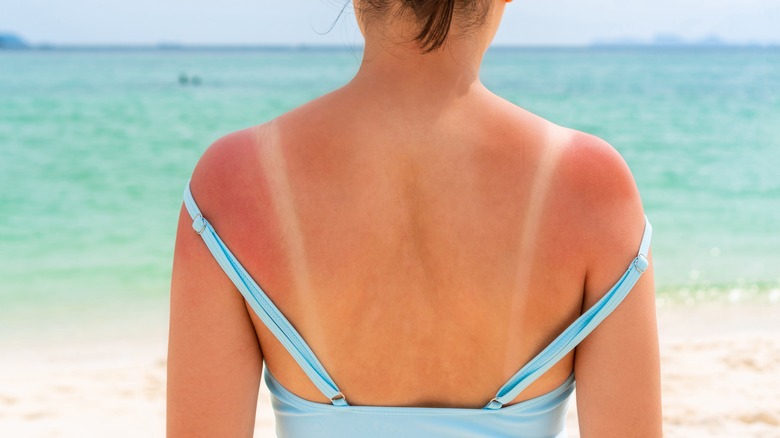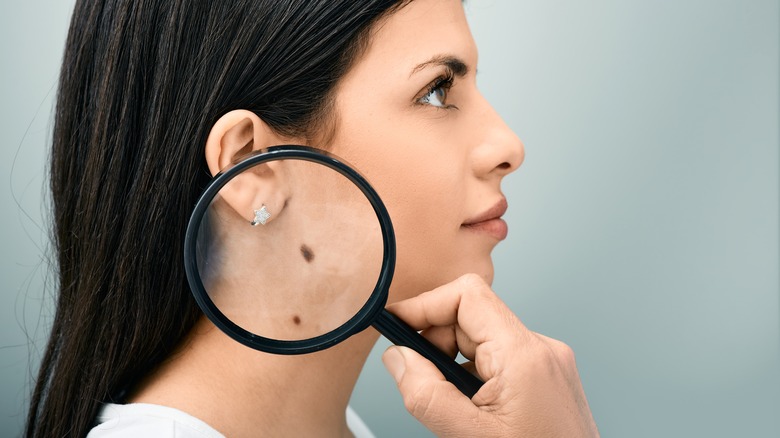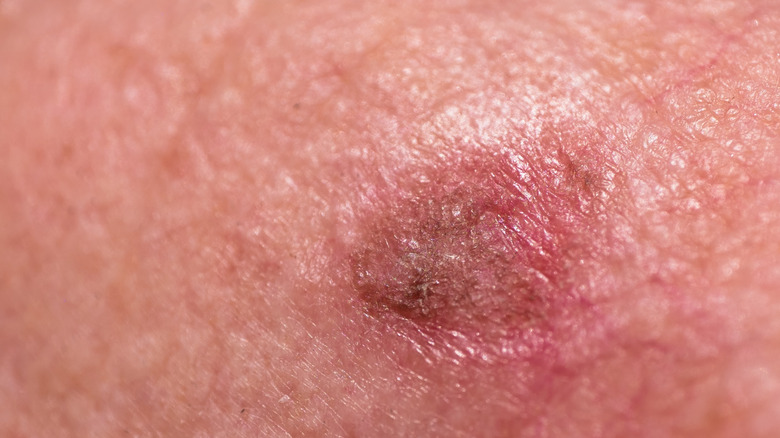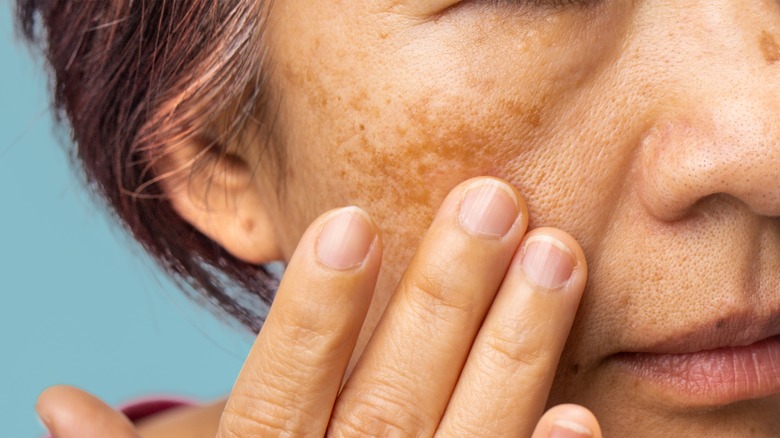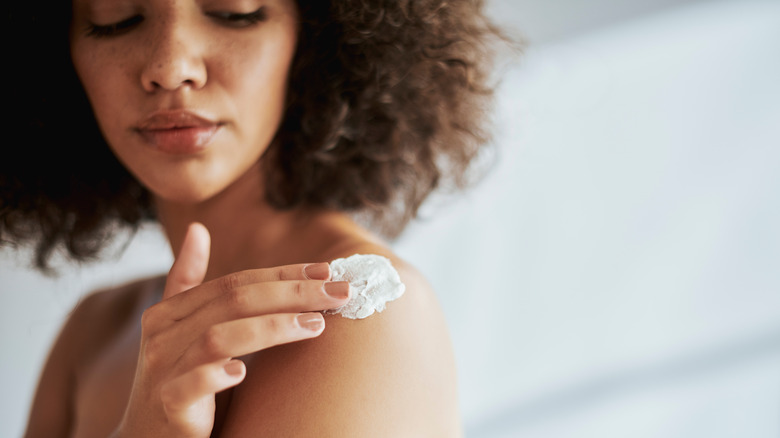Signs Of Sun-Damaged Skin That You Should Be On The Lookout For
There's nothing quite like the warm glow of the sun on our skin to make us want to stay outside all day. But remember — we can't have too much of a good thing. Over time, the sun can damage our skin when we aren't protecting it, and a lot of people forget how dangerous it really is not to wear SPF daily. No matter what skin type you have, anyone can experience sun damage. In extreme cases, sun damage can lead to skin cancers. In fact, the two leading causes of skin cancer are the sun's ultraviolet (UV) rays and tanning beds, per the Skin Cancer Foundation.
That's right: Tanning itself is technically a form of sun damage. When exposed to UV rays, the skin will produce more melanin, giving you that golden glow. Though you may look and feel great, it's dangerous to tan for long periods of time, as it increases the risk of skin cancer — including melanoma, the most serious form of skin cancer. By paying attention to your skin, you can prevent sun damage and decrease your risks of skin cancer. Here are a few of those different signs to watch out for if you spend a lot of time in the sun and what you can do if you notice them appearing.
New moles or changes to existing moles
There are several types of moles, and most of the time, they are completely benign and no cause for alarm. But it's still important to pay attention to how they look. Many appear in childhood due to genetics and sun exposure, but when new moles start to appear or you notice changes in the moles you already have, this could be a sign of a skin condition or even skin cancer.
According to the American Academy of Dermatology, you can use the "ABCDE" rule to determine if a mole is potentially harmful or cancerous. The acronym stands for asymmetry, border, color, diameter, and evolving. Using this rule, the warning signs of melanoma include an asymmetric mole with two differently shaped halves, an irregularly or poorly defined border, color variation, a size of more than 6 millimeters, or a mole that has changed over time and looks different from the rest.
Do a self-check on yourself regularly and see if you notice any new changes to your skin. While it's also a good idea to make an appointment with your dermatologist for a professional skin check, it's especially important if you notice new moles, changes to your existing moles, or when a mole is itching or bleeding.
Unfamiliar growths (i.e. actinic keratosis)
Actinic keratosis, also called AK, is a precancerous skin growth that develops as a result of skin damage from UV exposure. AK is a very common skin condition, with over 40 million Americans developing them every year, per the American Academy of Dermatology. These growths show up as reddish spots mostly on the face, ears, scalp, hands, neck, and lips — areas that see a lot of sun when not protected. They feel rough and tender to the touch and may look like a rash or a breakout. They may also appear to be skin-colored, yellow, or white.
Because AKs may look like just skin irritation or pimples, people may not know they have them until seen by a dermatologist. When caught by a dermatologist, AKs can easily be treated depending on the size, appearance, and quantity of AKs you have. When left untreated, AKs can develop into a type of skin cancer called squamous cell carcinoma, which is treatable when caught early.
Dark patches (melasma)
If you've noticed patches or spots that appear darker than your natural skin tone, this is a sign of melasma, another condition that forms as a result of sun damage. Melasma commonly appears on the face, but people can also develop it on the arms, neck, or jawline. It's commonly caused by the production of melanin that occurs when we're exposed to sunlight, and it can also be triggered by hormones during pregnancy, according to the American Academy of Dermatology.
While it's noticeable to the eye, melasma doesn't cause any pain or itching. It's not as serious as growths or new moles, but it's still a sign that your skin needs some more protection. Exposure to sunlight triggers melasma and can make it more noticeable, so it's important to protect your skin with SPF and protective clothing.
According to the American Academy of Dermatology, a dermatologist can prescribe medications that decrease the appearance of melasma. These can include a combination cream of tretinoin and corticosteroid, hydroquinone, or gentler medications like vitamin C or kojic acid.
Age spots and wrinkles
Aging is a normal part of life, and everyone gets wrinkles. But if you're concerned about preventing them early, it's important to wear sunscreen daily and have a healthy skincare routine that works for you. According to the Skin Cancer Foundation, people who use sunscreen with an SPF of 15 or higher every day show roughly 24% less skin aging than those who don't. The majority of skin aging — an estimated 90% — is caused by sun exposure. If you're not one to embrace your wrinkles, injectable fillers, Botox, and chemical peels can help eliminate signs of aging — but note that these are a temporary (and often expensive) fix. Reducing your sun exposure and protecting yourself when you do hang out outside can slow this process and stave off corrective procedures for a longer amount of time.
Along with wrinkles, age spots are most common for people over the age of 40 who have fair skin and a history of being in the sun or tanning frequently, per Healthline. These spots are typically a light brown to dark brown in color and are flat to the touch — and while you can't avoid these entirely, appropriate sun protection can reduce them.
Treating sun-damaged skin
If you're seeing any of these signs of skin damage, the best way to take care of your skin is to wear sunscreen daily, even on overcast days. Though it's difficult to reverse sun damage on your skin, you can still take care of the damage that's already been done and prevent more from occurring.
For an over-the-counter treatment, retinol is effective in treating sun-damaged skin, according to Dr. David Bank at the Skin Cancer Foundation. Retinol is derived from vitamin A and works by increasing the skin's collagen production. "It can even out pigmentation and help fade brown spots. It can make the skin smoother and softer, and even diminish fine lines and wrinkles," Dr. Bank says.
If you're looking to eliminate sun spots, Dr. Bank recommends laser treatments. "Some lasers target the pigment melanin, so they're basically designed to zap away sun spots," he says. For more serious skin problems like growths and new moles, it's always a good idea to talk to a dermatologist to get your skin checked out and determine the necessary treatment options that are right for you.
